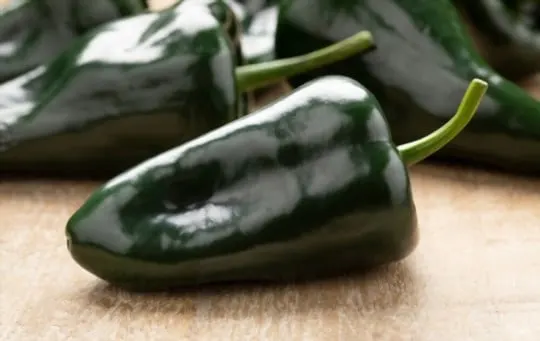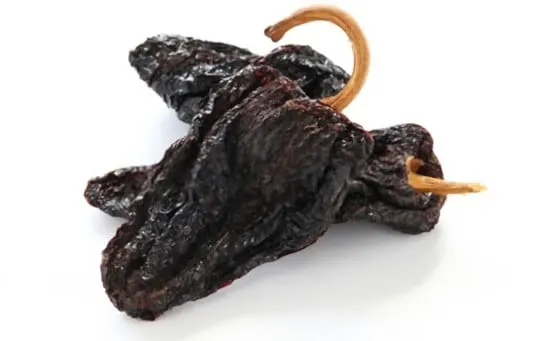Poblano and Ancho peppers bring the heat and sweet to our plates.
They’re not just peppers; they’re a flavor fiesta.
Did you know Poblanos are the fresh, crisp green guys?
Once they take a sunbath and age like fine wine, they turn into Anchos, boasting a sweet, smoky vibe.
We’ve all been there, standing in the grocery aisle, puzzled by these peppers.
Let’s crack the code together. Our kitchens have seen it all – the good, the bad, and the spicy.

What is Poblano?

Poblano peppers are a mild chili pepper originating from the Puebla state in central Mexico.
Typically, these peppers are dark green and have a heart-shaped appearance with pointed tips.
They have a rating ranging from 1,000 to 2,000 Scoville heat units.
Poblanos have thick walls, making them ideal for stuffing due to their larger size.
When roasted, the smokiness and sweetness of poblano peppers emerge giving them a unique flavor profile.
This pepper is extensively utilized in traditional Mexican cuisine such as Chile Relleno and Mole Sauce.
In comparison to Ancho peppers, which develop from dried poblano peppers, Poblano peppers are known for their milder heat level and juicier flesh.
Thus, it makes them a better option for stuffed dishes like chile rellenos or soups when compared to ancho peppers’ thicker skin that makes them perfect for dry rubs.
What is Ancho?

Ancho peppers are a popular variety of chili pepper that is widely used in Mexican and Southwestern cuisine.
Ancho chilies come from the dried poblano pepper, which is a mild chili pepper that is commonly used in various dishes.
The ancho pepper, on the other hand, is slightly spicier than the poblano but isn’t as hot as other varieties of chili peppers like jalapeños or habaneros.
Instead, it has a rich and smoky flavor with hints of raisin and chocolate.
So, let’s explore more about this fascinating variety of chili pepper.
- Ancho peppers are larger than poblanos, typically measuring around 3-5 inches long and 2-3 inches wide.
- Dried ancho peppers range from deep reddish-brown to black in color and have a wrinkled texture.
- These chilies have a Scoville heat rating of 1,000-1,500 units, making them milder than some other chili peppers but still capable of adding plenty of flavor to dishes.
- Ancho peppers can be used whole or ground up into powder form depending on your preference.
- These versatile chilies work great in sauces, marinades, stews and soups, and also pair well with meats like pork or beef.
When cooking with ancho peppers it is important to remember that they can be quite intense in flavor so use them sparingly at first.
Additionally, before using them in recipes make sure to rehydrate them by either soaking or boiling them beforehand.
Overall ancho chilies are a fantastic ingredient to have on hand if you want to add some extra depth and smokiness to your dishes without going overboard on heat levels.
Differences Between Poblano and Ancho Peppers

When it comes to Mexican cuisine, the use of peppers is quite common.
Poblano and Ancho are two popular varieties, but what sets them apart?
Poblano is a large green pepper with a mild flavor, while Ancho is dried and has a deeper, smokier taste.
Although both peppers come from the Capsicum annuum species, they have different appearances and unique culinary uses.
While poblano is often used fresh in dishes like chiles rellenos, ancho peppers are used mostly in their dried form for sauces, soups, and marinades.
While both peppers have distinct flavors and culinary uses, they can be substituted for each other in most recipes.
However, it’s important to note that when substituting poblano for ancho or vice versa, there may be minor differences in taste.
In terms of spiciness levels between the two peppers, poblanos are generally considered milder than anchos.
In summary, whether you prefer poblano or ancho peppers largely depends on your personal taste preferences and what dish you plan to prepare.
Ultimately both of these peppers bring a lot of flavor to any meal they are used in.
Origin and Appearance
Poblano and Ancho peppers share a significant resemblance, but they differ in certain aspects that make them unique.
These peppers originate from Mexico, although their cultivation has now spread globally.
They both belong to the Capsicum annum species, which also includes jalapeño and bell peppers.
In terms of appearance, Poblanos are large and slightly curved with a dark green color when unripe that turns to red when ripe.
On the other hand, Anchos have a deep red color with a wrinkled skin texture.
The differences between Poblano vs Ancho peppers extend beyond their physical attributes.
While both are commonly used in Mexican cuisine, they have distinct flavor profiles and heat levels.
Poblanos are mild in taste, with an earthy and slightly sweet flavor with minimal spiciness.
In contrast, Anchos are much spicier than Poblanos.
Their heat level can range from mild to hot depending on whether they are dried or fresh.
Overall, while Poblano peppers are known for their rich flavor and versatility in cooking, Ancho peppers’ spicy flavor makes them perfect for spicing up a variety of dishes.
Understanding the unique characteristics of these two types can help us use them optimally based on our desired outcome in any recipe that demands pepper addition.
Heat Level and Scoville Scale
Peppers’ heat level is measured using the Scoville scale, which assigns a numerical value to their spiciness.
When it comes to peppers, the higher the score on the Scoville scale, the hotter they are.
Poblano and ancho peppers both fall within a moderate range on this scale, indicating that they are generally milder than other chili varieties.
However, there are some differences between these two types of peppers that should be considered while deciding which is a better option.
Ancho peppers are dehydrated poblano peppers and have a sweet and fruity flavor with smoky undertones.
They have a lower potency as compared to fresh poblanos and remain at 1k-4k SHU (Scoville Heat Units).
Whereas, poblano peppers tend to be larger in size compared to ancho and are milder with a subtle earthy taste due to their dark green color; they range between 1k-2k SHUs.
Therefore, when it comes to spice levels, one must choose according to personal preference and recipe specifications.
Interestingly enough, poblano pepper originated from Puebla city in Mexico while Ancho pepper has its roots traced back to Mexico Byzantine period between 300 AD – 900 AD where it was used mostly dry for adding flavoring into dishes.
Hence both of these peppers can add authentic Mexican flavor and richness but need distinguished considerations before use in cooking.
Flavor Profile and Culinary Uses
Poblano and Ancho Peppers are commonly used in Mexican cuisine, but which one is better suited for your dish? The flavor profiles of these peppers differ, with Poblanos having a mild to medium heat and Anchos delivering a sweet smoky flavor.
Both can be used in salsas, sauces, stews, and even baked goods.
In terms of culinary uses, Poblano peppers are great for adding depth to soups and stews.
They can also be roasted and stuffed for chiles rellenos or sliced into strips for fajitas.
Ancho peppers are ideal for making marinades and rubs as they add a deep, rich flavor to meats like pork or beef.
They can also be ground into powder to make mole sauce or mixed with chocolate for a unique dessert.
One unique detail is that Poblano peppers are typically harvested when green while Ancho peppers are allowed to ripen to a deep red color before being dried.
This affects the flavor as the longer ripening process creates more sweetness in the pepper.
Ultimately, the choice between these two depends on personal preference and specific recipe needs.
Size and Shape
The shape and size of Poblano and Ancho Peppers are a crucial factor that sets them apart from each other.
Poblano peppers are usually wider than they are long, resembling a heart shape, with a flat, rounded bottom.
In contrast, ancho peppers have thicker flesh walls and a more elongated and tapered shape.
It’s important to note that Ancho peppers technically belong to the poblano family but have a different appearance due to being dried.
This difference in form can greatly impact cooking as it affects preparation time, stuffing capacity, and even roasting times.
Similarities Between Poblano and Ancho

Both Poblano and Ancho peppers belong to Capsicum annuum, a species of chili pepper family.
As mature fruit, they have nearly identical appearances on the exterior.
They possess a dark green hue that transitions into reddish-brown when ripe, forming a waxy and smooth skin texture.
The average length of both types measures about 4 to 5 inches with measurement variations according to its growth stage.
Similarly, these two cultivars have mild and smoky flavors when dried or grilled compared to other chili peppers in the family.
Like most chilies, it is also rich in vitamins A and C.
Moving on from common qualities.
The main difference between them lies at their maturity stages; Ancho peppers are ripe while Poblano is raw or under-ripe.
Once used for drying purposes, the former’s skin turns entirely purple-red while encouraging a sweeter flavor than Poblano’s earthy tones after re-hydration.
Besides Mexican cuisine recipes such as soups or salsa sauce, Ancho chilies also add flavorful depth to mole paste.
On the other hand, roasted Poblanos often become an essential ingredient for making Chile Relleno or Rajas con Crema dishes due to their meaty-like texture and less spicy taste.
In summary,.
Though they may look alike on the surface, these two chili cultivars serve different culinary objectives based on taste preferences.
Depending on your recipe requirements or spice tolerance level, pick one that suits you better.
How to Use Poblano and Ancho in Cooking
Poblano and Ancho peppers are two popular chili peppers used in cooking.
They differ in size, heat level, and flavor.
Poblano peppers are larger, milder, and have a slightly fruity flavor.
Ancho peppers, on the other hand, are smaller, hotter, and have a sweeter taste with hints of raisins and chocolate.
To use Poblano peppers in cooking, they can be roasted, peeled, seeded and added to soups or sauces as a base for flavorful dishes such as chiles rellenos.
They can also be sliced thinly and used as a topping for pizzas or sandwiches.
Ancho peppers work well in sauces and stews due to their deeper smoky flavor profile.
To use them in cooking, rinse them under cold water to remove any dirt or debris before removing the stem and seeds.
Toasting them lightly on a dry pan over low heat can help enhance their flavor before adding them to dishes like mole sauce or chili con carne.
It’s important to note that both Poblano and Ancho peppers can have varying degrees of spiciness depending on their ripeness.
Green Poblanos tend to be milder than red ones while red Anchos can be spicier than dried ones.
Choosing Between Poblano and Ancho: Factors to Consider
When selecting between poblano and ancho peppers, there are several factors to consider.
These factors include the level of spice, texture, size and flavour.
The spiciness of poblano peppers is lower than that of ancho peppers while the texture is firmer in poblanos compared to anchos.
Anchos have a sweeter and somewhat smoky taste while poblanos have a mild earthy flavour.
Another factor to consider when selecting between these types of peppers is the usage.
Poblanos are often used in more substantial dishes like chilies rellenos, soups or stews, whereas Anchos are better used as a dry ingredient in sauces, rubs or marinades.
Finally, some recipes specifically call for one type of pepper over others; therefore it’s essential to understand the specific requirements when choosing between poblano and ancho peppers.
In summary, choosing between poblanos and anchos depends on your needs – whether you need a mild or spicy flavor and whether you’re using them for soups/stews or as dry ingredients in sauces/marinades.
Whatever your preference could be, both peppers are tasty additions to any dish that requires a slight kick.
Heat Preference
Pepper heat level is an important factor in choosing the right type of pepper for your recipe.
Here are some points to consider when making your decision:
- Scoville Heat Units (SHU) measure pepper heat levels and range from 0 (bell peppers) to over 2 million (Carolina Reaper).
- For mild heat, consider poblano peppers with an SHU of 1,000 – 1,500.
- For medium heat, go for ancho peppers that have an SHU of 1,000 – 2,000.
- For hotter dishes such as spicy salsas or curries, try serrano or jalapeno peppers with an SHU between 3,500 -10,000.
It’s important to remember that individual tolerance levels vary.
Thus experiment and start with less quantity while cooking.
Find the perfect balance for you without overpowering the dish.
Recipe Requirements
When it comes to selecting peppers for your recipes, you can look beyond the basic red and green chili peppers.
If you want a deep flavor with mild heat, you can choose either poblano or ancho peppers.
These two types of peppers are very similar in taste and texture, but they have a few differences that will affect your recipe requirements.
Poblano pepper is usually larger than ancho pepper, but both of these sweet peppers are heart-shaped and come in dark green colors.
Poblanos have a fresh, grassy flavor with medium heat that ranges from 1000 to 2000 Scoville units.
Anchos are actually smoked-dried poblano peppers and have a fruity, earthy taste with low heat that varies from 1000 to 1500 Scoville units.
Depending on your recipe requirements, you can use either fresh poblano or dried ancho pepper flakes or powder as substitutes for each other.
Poblano is ideal for stuffing, roasting, frying, and grilling because it retains its shape well and has a thicker skin.
Ancho is perfect for making sauces, soups, stews, marinades, rubs because it has been dried which results in more concentrated flavor.
Availability and Accessibility
The accessibility and availability of these two peppers are largely dependent on geographic location and seasonal availability.
While poblanos are more commonly found in Mexican cuisine, ancho peppers are used mostly in Southwestern dishes.
Both can be found fresh or dried, but fresh poblanos tend to be easier to come by in American grocery stores.
Additionally, canned versions of both are becoming increasingly available in mainstream supermarkets.
It is important to note that the flavor profiles and spiciness levels vary between the two peppers, making them distinct options for different recipe needs.
Conclusion
After comparing Poblano and Ancho peppers, it can be concluded that both are great options for different recipes.
Poblano peppers have a milder taste while Ancho has a sweeter and smokier flavor.
The choice between them depends on the recipe and personal preference.
It’s worth noting that both types of peppers are incredibly versatile and can be used interchangeably in most recipes without compromising taste or texture.
In addition to their culinary uses, these two peppers also offer several health benefits.
Eating either Poblano or Ancho pepper can help boost metabolism, improve digestion, and lower inflammation.
Overall, when deciding which pepper to choose between Poblano vs Ancho, it’s essential to consider the taste preference of the dish being prepared.
Both excel at fulfilling their unique roles in various recipes without overlapping into each other’s categories.
